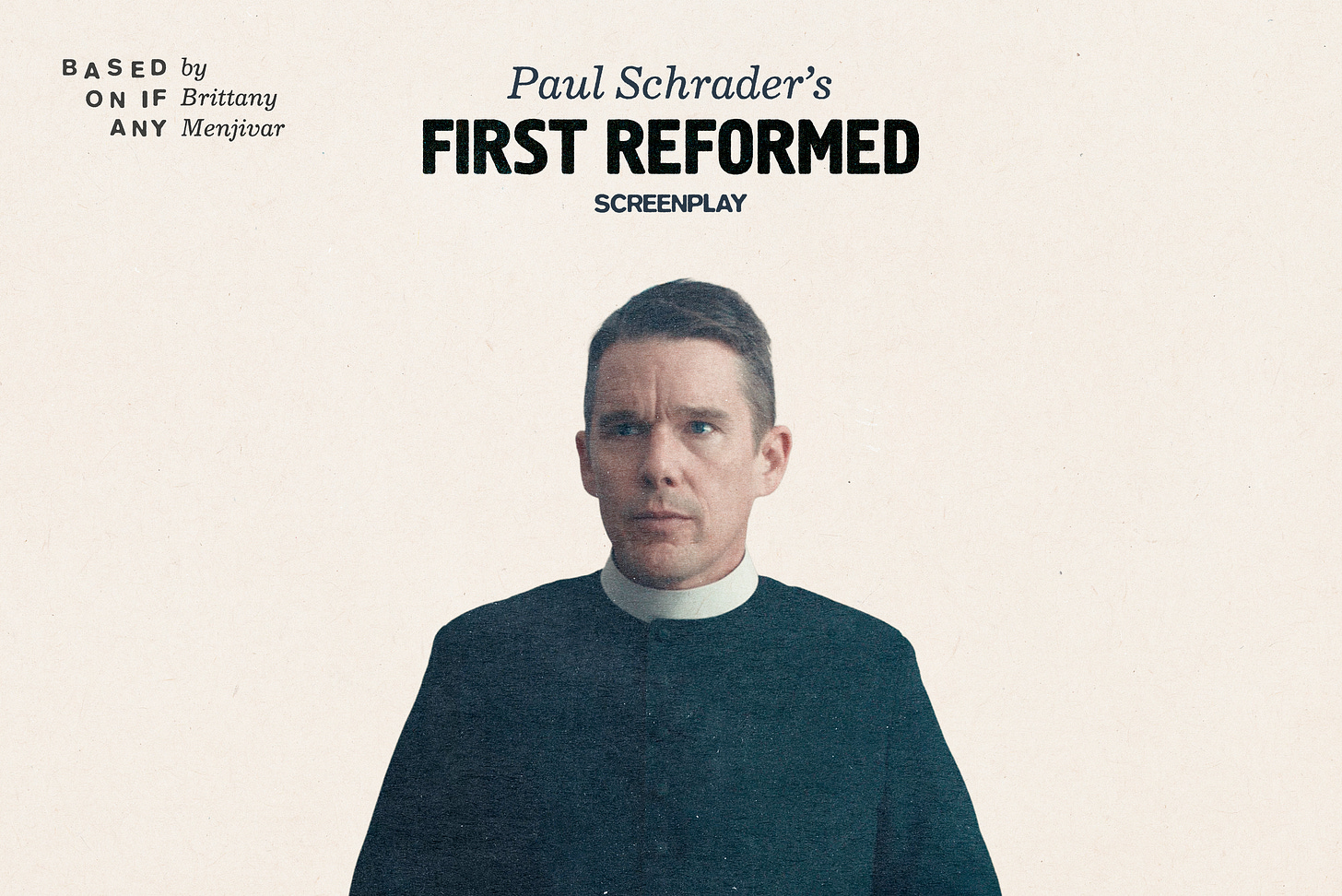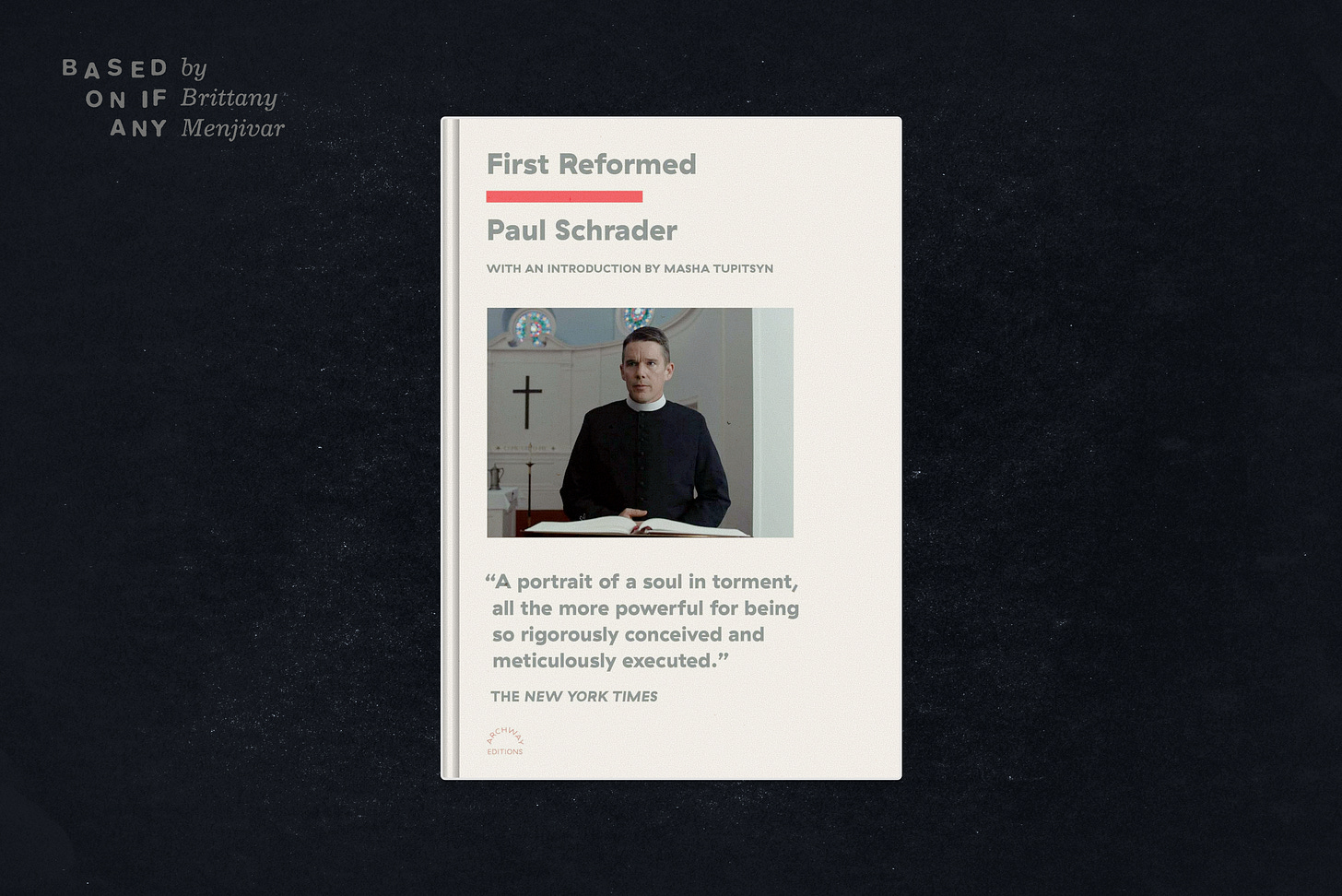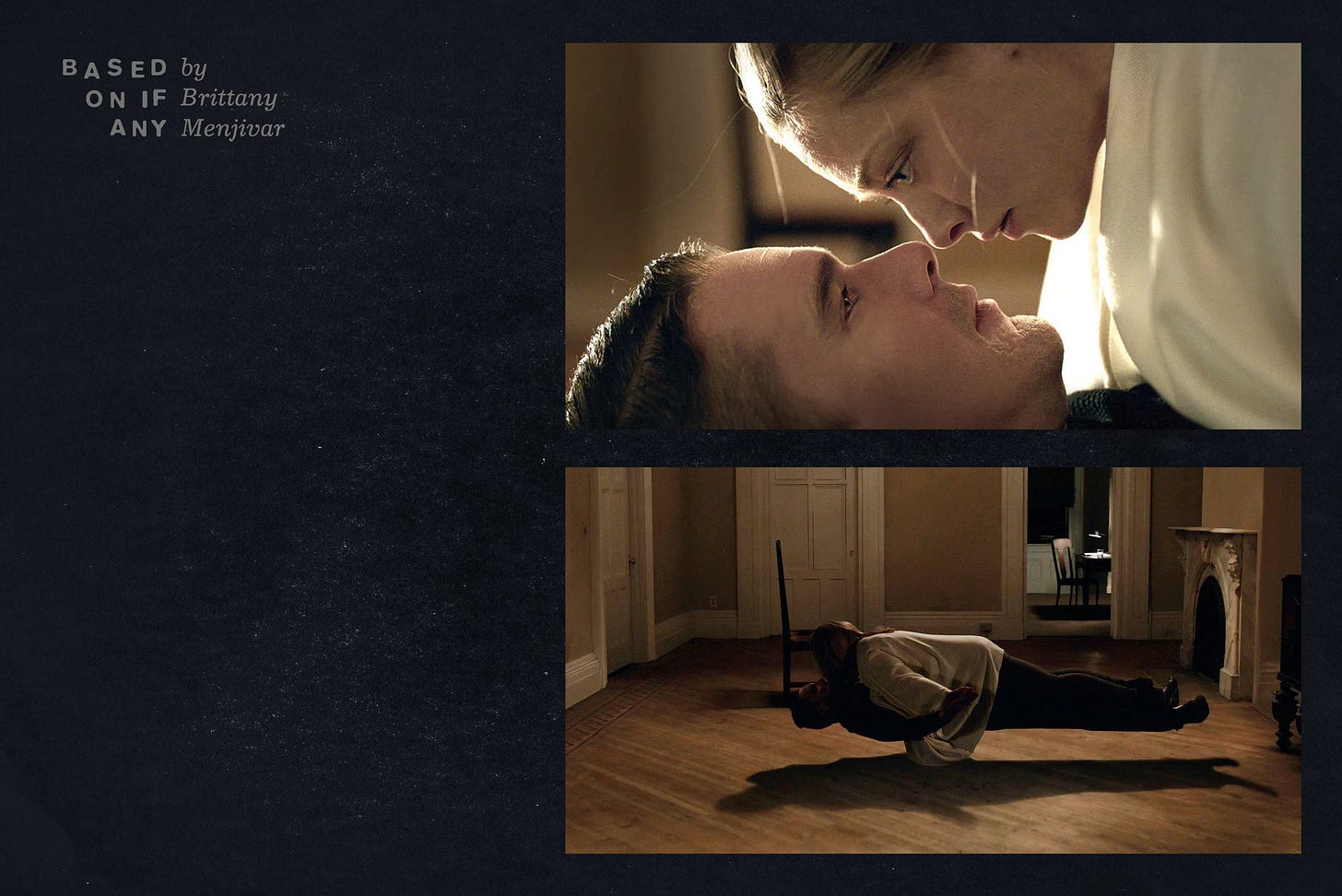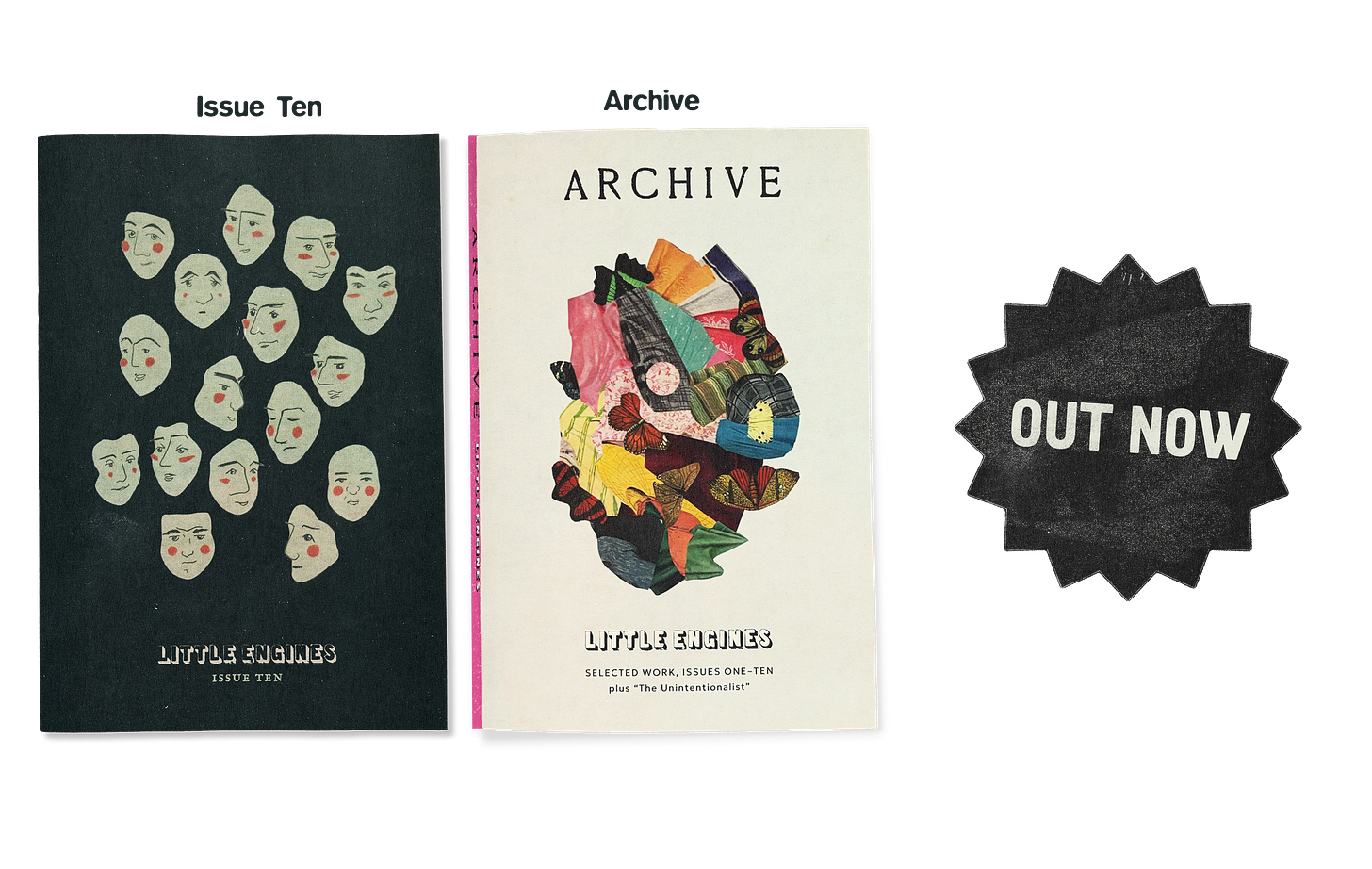Based On, If Any: First Reformed
Reading Paul Schrader via Archway Editions
Brittany Menjivar is watching adaptations. Previously: Nightmare on Elm Street, Nosferatu, The Polar Express, Secretary, Rave Macbeth, The Great Gatsby and Grand Theft Hamlet.
My fellow filmmakers sometimes say a screenplay isn’t itself a literary document. The people who argue this stance are often writer-directors we might consider auteurs; they don’t intend to disparage the art of screenwriting, but to call attention to the cross-curricular, collaborative work that goes into making a movie. I always push back when this opinion comes up. How come? The answer is simple: I came of age, creatively speaking, reading Paul Schrader.
It’s fitting that Schrader’s work often contends with Calvinist thought, as my first encounter with his work felt predestined. As a film student, I had to present my thesis screenplay to my entire writing workshop; I was shocked when my classmates told me that I had echoed several plot points from Taxi Driver, considering that I had never seen the film. I looked up the script—which Schrader penned for Scorsese—and was shocked by everything I read before the first slugline.
“The whole conviction of my life now rests upon the belief that loneliness, far from being a rare and curious phenomenon, is the central and inevitable fact of human existence.” —Thomas Wolfe, “God’s Lonely Man”
“He has the smell of sex about him: Sick sex, repressed sex, lonely sex, but sex nonetheless.”
“As the earth moves toward the sun, Travis Bickle moves toward violence.”
These words don’t directly translate to any singular shot in the film, but seeing Robert De Niro onscreen, shrouded in smoke and staring silently into space, the viewer knows them to be true.
Schrader’s thorough descriptions wouldn’t feel out of place in a novel, and while he hasn’t yet turned to literary fiction, the Oscar-nominated screenplay for his 2017 film First Reformed is available in book format via Archway Editions. First Reformed is separated from Taxi Driver by a gulf of 40 years, but the parallels are clear: while Taxi Driver centers an isolated, traumatized cabbie who spirals into violence, First Reformed features an isolated, traumatized preacher who spirals into self-destruction. Much like its forebear, the script is a master class for writers of all disciplines—and it’s just as much of a page-turner as any paperback.
The heart of a screenplay is the heart of its protagonist, and Schrader immediately lays Toller’s psyche bare. Before we follow him on his journey, we learn that “his face is like a rubbed away engraving on [a] tombstone… He is Agony.” As we get deeper into the plot—which involves Toller’s entanglement with the widow of an environmental activist and subsequent descent into eco-nihilism—Schrader cuts back on the exposition. Yet we continue to learn more about Toller, primarily through screen directions: we don’t just learn that Toller’s a reader but see the books on his shelf; we don’t just discover that Toller’s taking meds but find out which bottles are in his cabinet. Several years ago, dissecting authors’ scene-setting choices became the butt of an online joke due to one particularly pesky meme—“sometimes the curtains are just blue,” went the popular refrain, to the dismay of English teachers everywhere. Guess what, Internet—in a screenplay, constrained by industry-wide length requirements, if any color was mentioned at all there’s probably a good reason. Diving into a screenplay, the reader is reminded that every word and every image count.
Even as “show, don’t tell” remains wise advice, there are occasions when the invisible must be conveyed—a protagonist’s confusion during an emotional breakdown; ambiguous relationship dynamics that neither party can quite make sense of. How does the author explain that which characters can’t even explain themselves? First Reformed offers an answer: sometimes, it’s best not to. One of the film’s most distinctive sequences involves a ritual called “the Magical Mystery Tour,” which Mary used to perform with her late husband Michael as a means of stress relief. The two would lie on top of each other, fully clothed; then, staring into each other’s eyes, they would breathe in rhythm, eventually reaching a state of zen. When Mary comes to Toller late at night, distraught over Michael’s suicide, she invites him to recreate the ritual with her. The interaction that ensues is, at first, awkward—partly due to Mary’s grief, and partly due to Toller’s own existential turmoil, but also, it’s implied, because of the intimacy of the act. Is sexual tension brewing between the two, or is the viewer projecting?
Paging through First Reformed, I hoped for some additional insight, but Schrader’s calculated restraint was even more satisfying. Certain directions regarding line delivery provide an emotional framework for the interaction—there’s a “beat” after Mary elaborates on the tradition; she appears “shamefaced” after making her request. Yet the description of the actual moment is stark, focusing on choreography rather than emotional content. “Forehead to forehead, finger to finger, thigh and leg to thigh and leg” drives home the strangeness and potential subtext, but Schrader allows his audience to fill in the blanks. When romance does blossom between the two, it feels surprising and natural at once.
Reading the script for a film you’ve watched, the temptation to seek out secret information runs parallel to the desire to note deviations from the finished product. One such deviation that stood out to me was the song that the children’s choir performs at Michael’s funeral. In Archway’s version, Tracy Chapman’s “Rape of the World” soundtracks the scene; in the film, we hear Neil Young’s “Who’s Gonna Stand Up?”. Whereas Chapman’s song is more straightforwardly somber, Young’s is on the nose in its sloganeering. As Mary sobs wordlessly into a tissue, impassioned lyrics like “Protect the plants” and “End fossil fuels” multiply the discomfort everyone at the ceremony is feeling—and serve as a contrast to Toller’s hopelessness. This was the scene that cemented the film as one of my personal top ten of the century. I couldn't believe that it could have never existed—but who’s to say how the other song might have moved me? The joy of spotting differences isn’t determining which iteration is better, but reveling in the number of directions a project can veer in. During the revision process, it’s easy to get struck by decision paralysis—but First Reformed shows that possibility as exciting rather than terrifying.
Publishing a screenplay as a book might seem quietly transgressive and maybe even counterintuitive. A script in your hands can feel like a secret, the floor plan for a Disneyland dark ride—it’s not something you’re supposed to have access to. But there is something inherently prosocial about engaging with a project in a rudimentary or partial state. Trial and error is part of what makes us human, and amidst the AI boom, bearing witness to an artist’s creative process, the very thing that separates it from a computer, is not only historically significant but spiritually fulfilling. With all that said: I can’t wait for Schrader to publish Hardcore.







